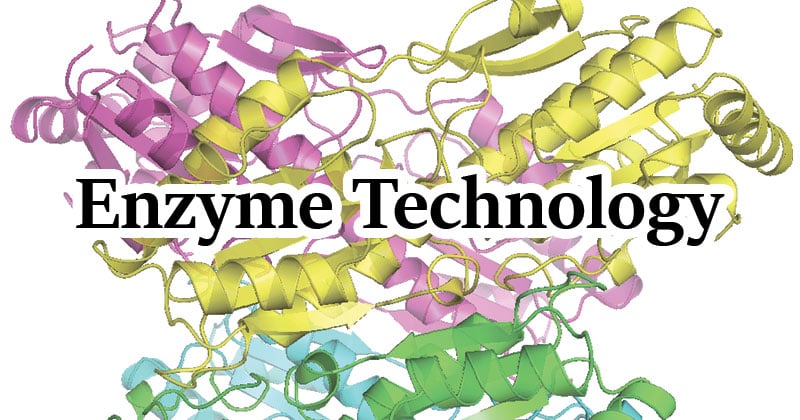- The enzyme is a substance that acts as a catalyst in living organisms, regulating the rate at which chemical reactions proceed without itself being altered in the process.
- Enzymes found in nature have been used since ancient times in the production of food products, such as cheese, sourdough, beer, wine and vinegar, and in the manufacture of commodities such as leather, indigo, and linen.
- All of these processes relied on either enzyme produced by spontaneously growing microorganisms or enzymes present in added preparations such as calves’ rumen or papaya fruit.
- The study of industrial enzymes and their uses is called enzyme technology.
- Enzyme technology broadly involves production, isolation, purification, and use of enzymes (in soluble or immobilized form) for the ultimate benefit of humankind.
- In addition, recombinant DNA technology and protein engineering involved in the production of more efficient and useful enzymes are also a part of enzyme technology.
- Enzyme technology today thus mostly refers to the application of altering an enzyme’s structure (and thus its function) or modifying the catalytic activity of isolated enzymes to produce new metabolites, to allow new (catalyzed) pathways for reactions to occur or to convert from some certain compounds into others (biotransformation).

Interesting Science Videos
Goal
To develop new and more sustainable products, processes and services to meet the human needs or to improve processes to produce existing products from new raw materials and biomass.
Significance of Enzyme Technology
Enzymes have a wide range of applications. These include their use in food production, food processing and preservation, washing powders, textile manufacture, leather industry, paper industry, medical applications, and improvement of environment and in scientific research.
As per recent estimates, a great majority of industrially produced enzymes are useful in processes related to foods (45%), detergents (35%), textiles (10%) and leather (3%).
- The products of enzyme technology will be useful for chemicals, pharmaceuticals, fuel, food or agricultural additives.
- A number of properties which may be improved or altered by genetic engineering as well as the yield and kinetics of the enzyme, the ease of downstream process and various safety aspects.
- Enzymes from dangerous or unapproved microorganisms and from slow-growing or limited plant or animal tissue may be cloned into safe high-production microorganisms. In the future, enzymes may be redesigned to fit more appropriately into industrial processes.
- Strategies that target mutagenesis to particular regions of a protein or use recombination to launch large sequence changes can complement full-gene random mutagenesis and pave the way to achieving ever more ambitious enzyme engineering goals.
Applications of Enzyme Technology
- In enzyme technology – a subfield of biotechnology – new processes have been and are being developed to manufacture both bulk and high added-value products utilizing enzymes as biocatalysts, in order to meet needs such as food (e.g., bread, cheese, beer, vinegar), fine chemicals (e.g., amino acids, vitamins), and pharmaceuticals.
- Enzymes are also used to provide services, as in washing and environmental processes, or for analytical and diagnostic purposes
Advances in Enzyme Technology
- New enzymes are being sought in the natural environment and by strain selection
- Established industrial enzymes are being used in as wide a variety of ways as can be conceived;
- Novel enzymes are being designed and produced by genetic engineering;
- New organic catalysts are being designed and synthesized using the ‘knowhow’ established from enzymology; and
- More complex enzyme systems are being utilized.
Future Applications
- The exploitation of enzymes as electrocatalysts (specific biosensors)
- Enzymes as analytical tools to measure specific compounds, for the regeneration of specific metabolites
- Enyzme utilization in the synthesis of bulk organic materials and the production of fragrances and cosmetics
- Enzyme utilization in the formation of food flavors and aroma compounds
- The use of enzymes as tools for the detoxification of pesticide residues
- Enzymes as monitors of toxic chemical levels in food and water
Biomedical applications of Enzyme Technology will include:
- The synthesis of new anti-microbial compounds
- Enzyme replacement therapy
- Enzymes in the treatment of cancer
- Enzyme graft and dermatological applications
- Enzymes as activators of precursor biomolecules
- Enzyme technology in the prevention of dental cavities
References
- https://www.omicsonline.org/scholarly/enzyme-technology-journals-articles-ppts-list.php
- https://www.britannica.com/science/enzyme
- https://www.sciencedirect.com/book/9780444641144/advances-in-enzyme-technology
- http://www.biologydiscussion.com/enzymes/enzyme-technology/enzyme-technology-application-and-commercial-production-of-enzymes/10185
- http://www.biologymad.com/studentswork/12%20-%20etnotes.pdf
- https://www.kth.se/dib/enzyme-technology-1.783173
- http://www1.lsbu.ac.uk/water/enztech/whither.html
- http://www.odofin.com/enzyme%20technology.htm
- https://www.thesciencenotes.com/enzyme-technology/
- https://application.wiley-vch.de/books/sample/3527329897_c01.pdf
